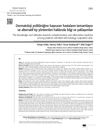
Search
for
Sort by
Research
450-480 / 1000+ results

research Cicatricial Alopecia with Particular Trichoscopic and Histopathological Features
The document concludes that a woman has both Frontal Fibrosing Alopecia and Lichen Simplex Chronicus, a previously unreported combination of conditions.

research Comparison of DNA Repair Systems in Infant, Children, or Adult Skin Cells—Impact of Full-Solar-Spectrum Irradiation
Infant skin cells may be less capable of repairing UV-induced DNA damage than adult cells.

research Psychodermatology in the UK: Psychological Impact of Skin Diseases and Importance of Services
Mindfulness reduces anxiety and depression in skin disease patients; dermatologists and psychiatrists often lack confidence in treating psychodermatological conditions.

research DC-HIL+ Myeloid-Derived Suppressor Cells Are Elevated in the Peripheral Blood and Lesional Skin of Cutaneous Lupus Patients
Cutaneous lupus patients have higher levels of certain immune cells in their blood and skin.

research IL-17C: Checkpoint in Innate Skin Immunology
IL-17C is important in inflammatory skin diseases and could be a target for treatment.

research Oral Dysbiosis in Palmoplantar Pustulosis Patients with Arthro-Osteosis
People with palmoplantar pustulosis, especially with bone issues, have different mouth bacteria compared to healthy people.

research A First-In-Human Study of BLZ-100 (Tozuleristide) Demonstrates Tolerability and Fluorescence Contrast in Skin Cancer
BLZ-100 is safe for use in skin cancer surgery and may help identify cancerous tissue.

research High Amphiregulin Expression Is a High-Risk Feature of Acute Graft-Versus-Host Disease of the Skin
High amphiregulin in the skin is a bad sign for acute graft-versus-host disease.

research Randomized Split-Side Study Comparing Efficacy of Botulinum Toxin Type A Versus 0.9% Sodium Chloride in Scalp Psoriasis
Botulinum toxin type A significantly reduces scalp psoriasis severity compared to placebo.

research Dermatological Manifestations of Obesity
Obese people are more likely to have certain skin conditions like dark patches, stretch marks, skin tags, and bumpy skin.

research Would You Recognize This Lesion as a Gumma Syphilitica?
LED light helps hair follicle cells grow and prevents them from dying by activating certain cell pathways.

research Wnt/β-Catenin and ERK Pathway Activation: The Possible Mechanism of Various LED Light Regulating the Proliferation of Human Outer Root Sheath Cells
LED light helps human hair root cells grow and move by activating certain cell pathways.

research Wnt/B-Catenin and ERK Pathway Activation: The Possible Mechanism of Various Light-Emitting Diode Light Regulates the Proliferation of Human Outer Root Sheath Cells
LED light helps human hair root cells grow and prevents them from dying by activating specific growth pathways.

research Dermatologic Toxicities Associated with Chronic Gamma-Secretase Inhibitor Treatment for Desmoid Tumor
Most patients experienced mild to moderate skin problems during a trial for a desmoid tumor treatment.

research The Knowledge and Attitudes Towards Complementary and Alternative Medicine Among Patients Admitted to Dermatology Outpatient Clinic
About 30% of dermatology patients used complementary and alternative medicine, mostly women with higher education and income, but 85% still preferred traditional medical treatments.

research Prevalence of Skin Diseases in a Dermatology Outpatient Clinic in RIMS, Kadapa: A Cross-Sectional, Retrospective Study
The most common skin diseases found were contact dermatitis, scabies, fungal infections, urticaria, and acne, highlighting the need for better public health policies and awareness.

research Increasing Mupirocin Resistance in Pediatric Methicillin-Resistant Staphylococcus Aureus Skin and Soft-Tissue Infections in New York: A Genomic Approach
There's a growing resistance to the antibiotic mupirocin in children's skin infections caused by MRSA in New York.

research Immune Signatures of Psoriasis: Comparison of Genetic Expression Profiles in Psoriasis Patients After Therapy with Biologic Agents
Treatment with biologic agents can significantly improve psoriasis symptoms, and blood biomarkers could potentially predict individual patient's response to treatment.

research US Dermatology Workforce from 1995 to 2011: A Geographic Analysis
The number of dermatologists in the US increased from 1995 to 2011, but they were unevenly distributed, mainly in urban areas, and areas with higher income and education levels.

research Dermatologic Applications of Direct-to-Consumer Genomic Analysis
Living near more dermatologists and using certain cancer screening tests lowers the chance of being diagnosed with advanced skin cancer.

research What Bothers You Most About Your Skin Cancer? 700 Patients Respond
Patients with nonmelanoma skin cancers are most bothered by fear of progression, appearance concerns, and having cancer.

research Changing Incidence Trends of Cutaneous B-Cell Lymphoma
The number of new cases of cutaneous B-cell lymphoma has leveled off since the early 2000s, and survival rates have improved since 1973.

research Cost of Prevalent Psoriasis: A Population-Based Analysis
Psoriasis increases annual healthcare costs by $4,044 per patient, with biologic treatments costing significantly more than phototherapy.

research Differential Diagnosis of Trichotillomania by Trichoscopy
Azathioprine may help with severe hair loss, a new topical treatment could counteract hair thinning, and trichoscopy can diagnose hair-pulling disorder effectively.

research Cortexolone 17a-Propionate: A New Antiandrogen Acting on Hair Dermal Papilla Cells for the Treatment of Androgenic Alopecia
Cortexolone 17a-propionate may be an effective new treatment for hair loss.

research Digital Measurement of Melasma: Towards Eliminating Subjectivity from Treatment Evaluation
The digital system for measuring melasma shows promise but needs more development for better accuracy and automation.

research The ProScope HR: A Promising Diagnostic Tool
The ProScope HR is an effective, user-friendly, and affordable tool for diagnosing hair loss.

research Eruptive Vellus Hair Cysts Treated With Lactic Acid: Case Report and Review of the Literature
Lactic acid cream can help improve skin bumps known as eruptive vellus hair cysts.

research Scleromyxedema With Neurologic Involvement: Therapy With Intravenous Immunoglobulin
Umbilical cord blood transplantation improved the boy's symptoms despite complications.